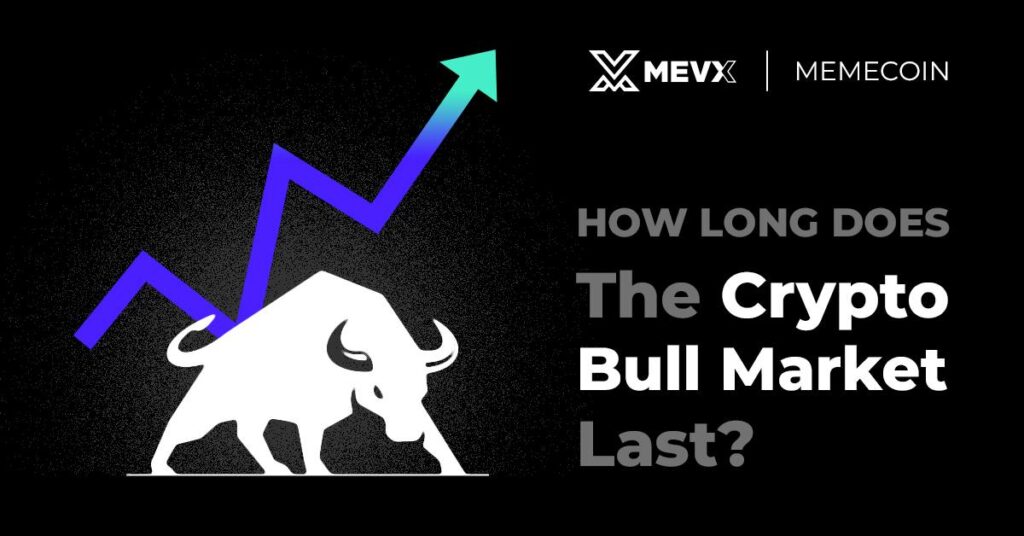How long does the crypto bull market last? The cryptocurrency market is notoriously unpredictable, with extreme bull and bear runs between them. A cryptocurrency bull run can be characterized in terms of price appreciation, bullish activity, and increased activity in the marketplace. It is worth noting for investors, speculators, and enthusiasts in general that one must understand life-cycle behavior for such bull runs. In this article, we work through a review of bull runs in cryptocurrencies, a review of past bull runs, driving factors for them, and what past trends can possibly mean in terms of duration.

What Defines a Bull Market in Crypto?
A bull run in cryptocurrencies is marked with
- Significant Price Increases: Sustained price appreciations in major cryptocurrencies like Bitcoin (BTC), Ethereum (ETH), and a couple of others.
- Increased Trading Volume: High trading and transaction volumes.
- Positive Investor Sentiment: Optimistic future outlook, fueled by technology, media, and even breakthroughs in terms of regulation.
- Adoption and Innovation: Institutional investments, new use cases, and even breakthroughs in terms of regulation can cause a bull run.
How Long Does the Crypto Bull Market Last?
To understand how long the crypto bull market lasts, there are some criteria in consideration. A few of them are:
Historical Crypto Bull Markets in Crypto
To understand how long a bull market lasts in cryptocurrencies have taken place, let’s go through a few examples in the past:
2011-2013 Bull Run
The first crypto bull run in Bitcoin saw its price climb from under $1 to over $1,000. That run took two years, between late 2011 and November 2013, before a sharp fall.
2017-2018 Bull Run
The ICO boom, for that’s become its name, saw numerous new cryptocurrencies and initial coin offerings (ICOs) make an entrance, and Bitcoin’s price rose from under $1,000 to nearly $20,000. That bull run took 12 months, with its high in December 2017.
2020-2021 Bull Run
Sparked in economies worldwide by stimuli, low interest rates, and institutional investing, this run saw Bitcoin climb over $60,000. Between January 2020 and its high in April 2021, this bull run took 16 months, but with a series of minor crests and troughs in between.

Factors Influencing Bull Market Duration
Several elements can affect how long a bull market lasts:
- Market Sentiment: Driven by news, social media, and overall economic conditions. Positive developments in blockchain technology or regulatory landscapes can extend a bull market.
- Institutional Investment: Institutional investors and larger entities entering into the marketplace can stabilize and extend bull trends. For instance, Tesla, MicroStrategy, and Grayscale have prolonged bull phases in the past.
- Supply and Demand Dynamics: Cryptocurrencies such as Bitcoin have a finite supply, and with growing demand, prices can rise. Bitcoin halving events, which reduce new coin supply, can impact duration in a marketplace.
- Technological Developments: Innovation in blockchain technology or new DeFi platforms, NFTs, and alternative use cases can drive bull cycles.
- Global Economic Conditions: Macroeconomic factors such as inflation, interest, and economic policies have a lot to say in it. In uncertain economies, crypto can serve as a hedge, prolonging bull phases.
- Regulation: Favorable regulatory regimes can stimulate use and investment, and strong laws can truncate a bull market
Predicting Bull Market Length
Predicting exactly how long a bull market will last is as much an art as it is a science:
- Chart patterns, moving averages, and other indicators might suggest when a market is overbought or due for a correction.
- Evaluating the underlying value of cryptocurrencies based on adoption, network growth, and blockchain metrics can provide insights.
- Using tools to gauge social media sentiment or analyzing news flow can offer clues on market direction.
- While history doesn’t repeat exactly, it often rhymes. Past cycles can inform but not dictate future durations.
The Average Duration

From historical trends, therefore, a conclusion can be drawn that:
- Short-term Bull Runs: Can vary between a period of a matter of a week and several months, initiated with a specific incident and events with a quick reversal thereafter.
- Medium-term Bull Markets: Can stretch for a period of roughly one year, for instance, in 2017. These occur both with investors’ demand and trends in the market.
- Long-term Cycles: The 2020-2021 cycle suggests that with a strong institutional presence, bull runs can stretch for a long period, even 18 months and beyond
The Bear Market Context
Understanding bull markets involves seeing them conclude, transitioning into a stage of bear markets:
- Price Correction: After a big gain, a cool-down period, a period of correction, is a natural progression.
- Cycle of Market Phases: Naturally, bull markets follow a stage of bull, and a stage of bears, and perhaps a long one at that, with a stage of healing for a recovered marketplace and renewed hope.
Strategies for Navigating Bull Markets
Survival techniques for bull markets can follow these techniques for investors:
- Diversification: Spread investments over many assets in order to safeguard them.
- HODL (Hold On for Dear Life): Others prefer holding through the tumult, banking value appreciating over the long term.
- Profit-Taking: Selling part of assets during high times can lock in profit.
- Staying Informed: Monitor trends in the marketplace, technological breakthroughs, and new legislation.
How long does the crypto bull market last? The duration of a bull run in cryptocurrencies will depend on a variety of factors, including economic trends, technological advancement, and investors’ moods. Historical trends can serve as a guideline, but no two cycles will ever be similar. Rather than predicting timelines, investors have to observe phases in a bull run, manage risk, and follow trends. With new trends in the ever-evolving crypto scenario having an impact, adaptability will be key for investors in a bull run.
Follow MevX Blog for more insights on the crypto market!
Share on Social Media:
